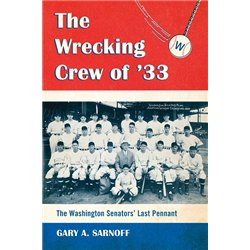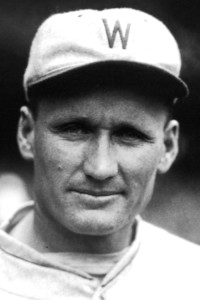Washington Senators – 1926 – Part 3
By Edwin Marshall, age 10.
Springfield, Illinois
My favorite ball player is Walter Johnson. I like him best because I want to be a pitcher like him. He is tall. He has a strong arm. He has lots of speed and everything a pitcher should have. He never blames anyone for an error, but he always has a good word for a player. This makes the player work harder to help him win games.
He pitches his best all the time, whether he is losing or winning. He is always ready to get into a game and never kicks about extra work. He plays a clean, square game all the time. He is the same kind of fellow off the field as when he is on the field. He likes to play with the boys, like me, and tell us how to play baseball. He lives a clean, healthy life, which helps him in anything he does. He goes not take all the glory, but gives others their share.
That is why he is my favorite, and I will always try to be like him.
For young Edwin Marshall, April 14th, 1926, was a day his dream came true. He had won an all expenses paid trip from his hometown of Springfield, Illinois to Washington DC by writing and submitting his essay in a contest, and he won. He won the grand prize of an all expense paid trip, and the opportunity of a life time – to see his hero in pitch and meet him.
Opening day in 1926 arrived on a cold day in the Nation’s Capital. The temperature was just forty-seven degrees. Nonetheless, twenty-five thousand true Washington baseball fans braved the elements and came to Griffith Stadium to cheer on the two-time American League champions in their quest to begin the season on a good note.
Walter Johnson, now age thirty-eight, was ready to begin his twentieth major league season. Coming off his
second consecutive twenty-win season, Johnson arrived in Tampa in good shape. The writers agreed that he looked good, was throwing hard, and one scribe said his fastball still created a loud “pop” when plunging into the catcher’s mitt. He was sidelined for a few days when he took a line drive on the hip in Tampa, hit by teammate Joe Judge during batting practice, but he was back in action within a few days.
As Johnson warmed up in preparation of pitching his fifteenth inaugural game of his career, something was on his mind. He had heard the talk about his age and being past his prime. And he had also endured a poor outing three days before against the Giants. Wanting to prove to the critics were wrong, and still smarting from his tough game from a few days before, Johnson had reason to be motivated to pitch a great game. And he also wanted to beat the team that was predicted to dethrone the Senators.
“Get Philadelphia” had been the Senators motto through the spring. The Philadelphia Athletics, a young and hungry team with a powerful hitting attack, an experienced pitching staff, and great team depth, arrived in Washington with hopes of setting the tune of the new season and erasing the bitter memories of 1925, when a late season losing streak knocked them out of first place and out of contention.
During batting practice, Al Simmons, perhaps the league’s best hitter in 1925, put on a great show by knocking several balls into the far distances of the bleachers. As the fans cheered and hollered after each long drive by the A’s outfielder, the Washington players watched with concern. They figured Simmons to be as good in 1926 as he had been the previous season, and they also knew that the young star of the Athletics was capable of carrying the entire club when he was hot at the plate.
The usual opening day festivities included the President throwing out the game ball and the traditional march by both teams to the centerfield flagpole. Making the first pitch this season was Vice-President Dawes, subbing for President Coolidge who was absent due to mourning the recent death of his father.
Six of the eight starters from the Senators everyday line up from previous season were in the opening day lineup. Muddy Ruel was behind the plate, Joe Judge at first base, manager Bucky Harris at second, Ossie Bluege at third, Goose Goslin in leftfield, and Sam Rice in center. The two newcomers to the lineup were Buddy Myer and Joe Harris.
Buddy Myer was starting since Peckinpaugh was not physically ready for the start of the season due to the unseasonably cold spring weather had delayed his injury recovery. Joe Harris, obtain by the Senators during the 1925 season, played so well after coming to Washington, manager Bucky Harris believed he had no choice but to insert him in the everyday lineup in right field.
“Walter was really fast for that opener,” Ruel would recall a year later. Johnson was at his best. He began by striking out Walter French and Al Simmons to end the top of the first. He then struck out Joe Hauser to start the second. So awed by Johnson’s fastball, Hauser shook his head and talked to himself while heading back to the Philadelphia bench.
A loud cheer rocked the stadium in the bottom of the third when Walter Johnson walked to the plate for his first at bat of the season. Time was then called, and Edwin Marshall was then escorted onto the field. He handed his hero a bouquet and a loving cup. The two posed for photographers, then shook hands.
After eight innings, there was still no score. Johnson was pitching a great game. Unfortunately for the Big Train and his teammates, Athletics knuckleball specialist Eddie Rommel was equally as good as Johnson. In the top of the ninth the A’s finally were able to get something going. A walk and a throwing error by Myer put two runners on base with only one out. A long fly ball for the second out of the inning advanced the lead runner to third base.
Two outs, a runner in scoring position, and Al Simmons was heading to the plate.
Bucky Harris was confident in his veteran pitcher, but worried he might be tiring. As a precaution he signaled to the bullpen, and two Washington hurlers got up of the bench and began to limper up.
Johnson verse Simmons: Power against power.
This was one the photographers needed to get. As Simmons stepped into the batter’s box and get ready, the cameramen inched their way closer to the third baseline in order to get the best shot of this match up.
Simmons was now ready. Johnson was ready. The hurler was about to go into his windup when home plate umpire Tom Connolly quickly called time out, and then turned to order the photographers to back off the field. After the cameramen obliged, play resumed, and Simmons grounded out to end the threat.
As Johnson and his teammates headed back to the dugout, Bucky Harris asked his hurler how he felt.
“I’m good for another (inning)” answered Johnson.
The Nats failed to score in their half of the ninth, and the game headed into extra innings. In the top of the twelfth the A’s once again mounted a threat by putting men on base for Simmons. And again Simmons grounded out. The next batter, Mickey Cochrane, flew out to end the inning. As the Nats headed to the bench after the conclusion of the inning, manager Harris once again spoke to his star pitcher.
“How do you feel?” asked Harris.
“I’m good for another,” replied Johnson.
The game was still undecided at the end of the thirteenth, and then the fourteenth. In the top of the fifteenth, Johnson once again took care of business.
“How do you feel?” Harris asked after the top half of the frame.
“I’m good for another,” said Johnson.
In the bottom of the fifteenth, with Rommel still pitching for the A’s, Bucky Harris led off with a single. Goslin followed with a smash off the right field wall for a double. Joe Judge drew a walk to load the bases for Joe Harris. The veteran outfielder came through with a hit to score his manager and end the game with a 1-0 win for Washington. Johnson had pitched fifteen scoreless innings, allowed just six hits, struck out twelve, and went the distance to record his first win of the new season.
As for Edwin Marshall, he headed back home as a very happy young baseball fan. He got to see his hero in action, he got to meet his hero, and he was included in the opening day festivities at Griffith Stadium. And best of all, he got to see Walter Johnson at his best.
1926 Washington Senators – Part One
1926 Washington Senators – Part Two
Gary is the author of The Wrecking Crew of ’33; The Washington Senators’ Last Pennant. Gary has written for Nats News, Minor League News, and for the Biography Project of the Society for American Baseball Research. He lives in Arlington, Virginia.







